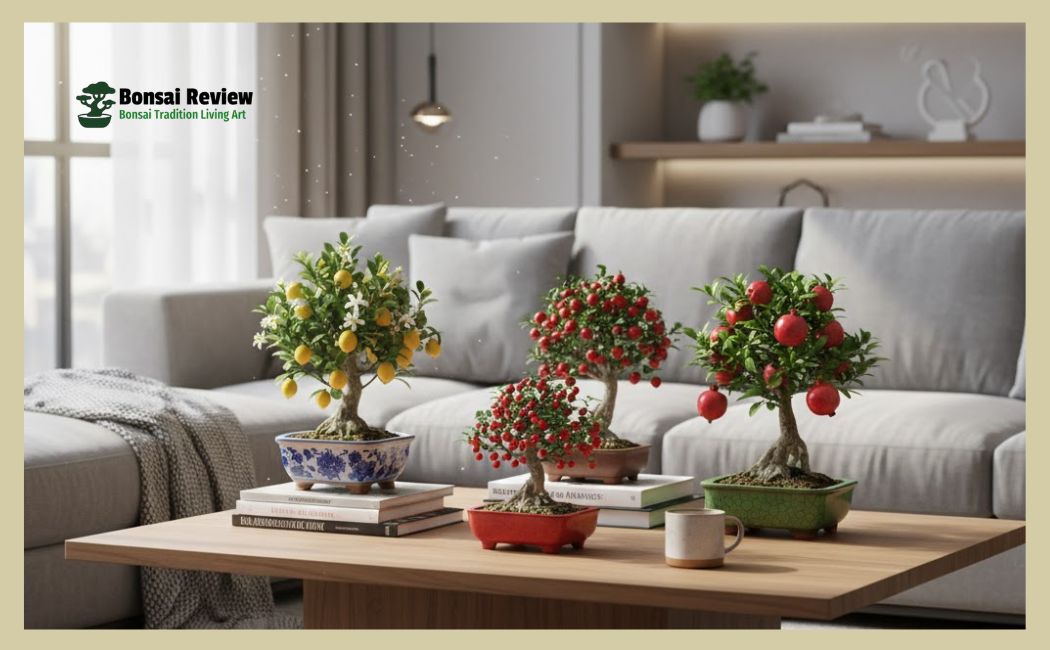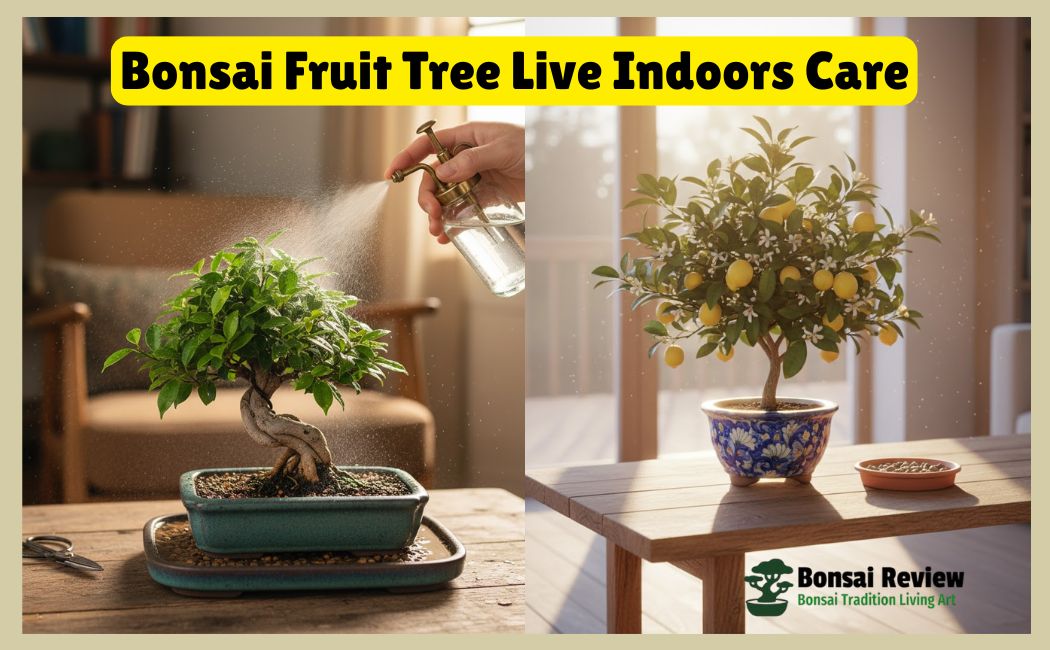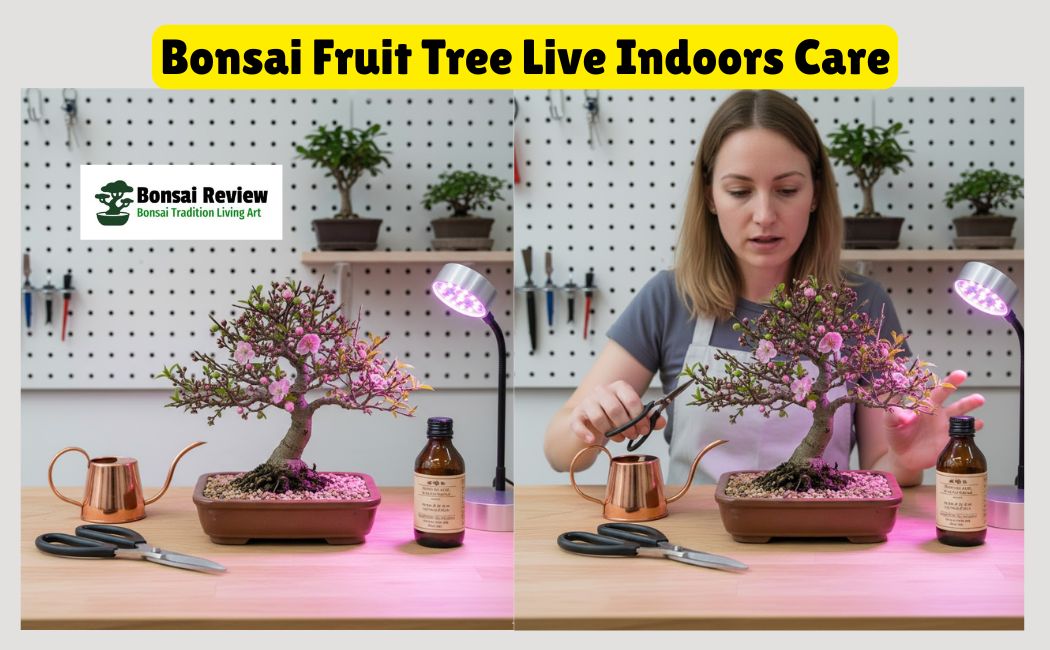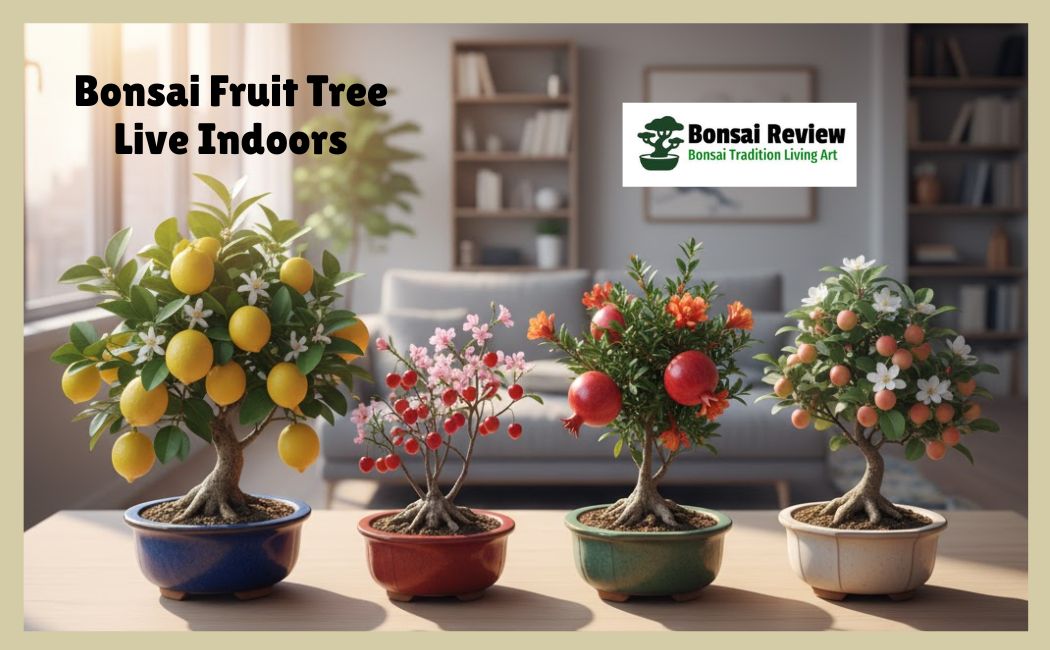Bonsai fruit tree live indoors beautifully when you choose the right kind and give it the right care. Maybe you’ve tried keeping plants inside before, but they didn’t last long.
Don’t worry, some tropical and subtropical bonsai species like Calamondin orange, Meyer lemon, or Ficus bonsai love indoor life. You can even grow pomegranate, cherry, apple, or mango bonsai that bear tiny, colorful fruits.
These trees stay healthy in steady indoor air, around 65–75°F, under bright light from a south-facing window or LED grow light. Keep the soil slightly moist, mist the leaves, and set a humidity tray below the pot.
You’ll find many options for sale on Amazon, Etsy, or Eastern Leaf, even under $45, from dwarf to large bonsai sizes. Soon, your home will glow with green leaves, pink blooms, and red or golden fruit, turning your room into a calm, living art corner.
Can Really Bonsai Fruit Tree Live Indoors USA and Canada?
Yes, bonsai fruit trees live indoors in the USA and Canada, but only the right ones. Most bonsai trees come from outdoor species that need cold winters or strong sunlight. That’s why some struggle inside. But bonsai fruit trees from tropical and subtropical species can happily live indoors all year.
These include Citrus, Ficus, Pomegranate, and Cherry bonsai trees. They enjoy steady indoor warmth between 65°F and 75°F, soft airflow, and bright light from a south-facing window or a grow light.
Think of your home as their gentle greenhouse, safe from harsh wind but filled with light and care. Keep your tree near natural light, mist it daily, and use a humidity tray to stop dry indoor air.
With the right setup, your indoor bonsai fruit tree can flower, fruit, and stay healthy through every season, even in zone 5, zone 6, or zone 9 homes where outdoor bonsai may not survive.

Top Indoor Bonsai Fruit Trees for Beginners: Citrus, Ficus & More
Best bonsai fruit tree live Indoors decor, and you can grow a bonsai decor, the right tree makes all the difference. Some bonsai fruit trees are born to live indoors because they come from tropical or subtropical climates that match your home’s steady warmth.
You can start with a Calamondin orange bonsai or a Meyer lemon bonsai, both of which love bright windows and reward you with fragrant white flowers and tiny golden fruits.
A Ficus bonsai, such as the Golden Gate Ficus, stays green all year and is one of the easiest trees for beginners. If you want color and charm, try a Pomegranate bonsai with fiery red blooms or a Cherry bonsai that shows soft pink blossoms before fruiting.
For something different, a Mango bonsai or Dwarf Apple bonsai adds a sweet surprise once it matures. You’ll find these trees for sale online on Amazon, Etsy, or Eastern Leaf, often under $45, and in sizes from small tabletop bonsai to large indoor statement trees. Pick one that matches your light, your space, and your care time, and soon, you’ll have your own little indoor orchard.
How to Care for an Indoor Bonsai Fruit Tree?
Caring for a bonsai fruit tree indoors is easy when you follow a few simple steps. These trees love steady warmth, soft air, and lots of light. Keep your tree where it can get 6–8 hours of sunlight daily near a south-facing window or under a full-spectrum LED grow light. The perfect indoor temperature stays between 65°F and 75°F, just like most tropical bonsai prefer.
Water your tree when the topsoil feels slightly dry, not soaked, not dusty. Always use a bonsai pot with drainage holes so extra water can escape. Add a humidity tray or mist the leaves each morning to stop dry air from hurting the buds and fruits.
Feed your bonsai with a balanced fertilizer (like 10-10-10) once every 2–4 weeks during spring and summer when growth is strong.
In fall and winter, feed less, but still keep light and warmth steady. Trim small shoots with bonsai shears to keep your tree’s shape neat and let light reach all branches.
If your bonsai drops leaves, don’t panic; it may be adjusting to new light or air. Just stay patient. With time and gentle care, your indoor fruit bonsai will bloom again, filling your home with green leaves and a sweet scent.

Common Problems Bonsai Fruit Tree Live Indoor and How to Fix Them?
Even the best bonsai fruit trees can face small troubles indoors, but each one has a simple fix.
1. Yellow Leaves: This happens when the tree gets too much water or too little light. Check the soil if it feels soggy; let it dry before watering again. Move your bonsai near a bright south window or add a grow light for extra sun hours.
2. Dry or Falling Leaves: Indoor air can get dry, especially in winter. Keep a humidity tray under your bonsai pot or mist the leaves once or twice a day. Some Citrus or Ficus bonsai may drop old leaves when adapting to new ones, which will soon grow back.
3. No Flowers or Fruits: Your tree needs strong light and the right food. Use a balanced bonsai fertilizer every few weeks in the growing season, and make sure the tree gets 6–8 hours of light. Citrus, Pomegranate, and Cherry bonsai usually bloom better when they rest in cooler air (around 60°F) for a few weeks each year.
4. Pests: Watch for spider mites, aphids, or scale insects under the leaves. Wipe them gently with a soft cloth dipped in neem oil or mild soapy water. Keep air moving around your bonsai, but away from cold drafts.
Each problem tells you something your tree needs. Once you listen and adjust, your indoor bonsai fruit tree will bounce back greener, stronger, and happier.
Benefits of Growing Bonsai Fruit Trees Indoors
When you keep a bonsai fruit tree alive indoors, you’re not just growing a plant; you’re creating a calm, living piece of art right inside your home. It gives beauty, balance, and joy every day.
1. Brings Nature Inside: You may not have a garden or yard, but with a bonsai citrus or apple bonsai, you can still enjoy green life and even real fruits in your living room. The small leaves and tiny fruits from orange to pomegranate fill your space with color and life.
2. Cleans and Freshens Air: Just like other indoor trees, bonsai help clean the air. Ficus bonsai, juniper, and lemon trees remove toxins and make the air fresher, especially in small spaces.
3. Stress Relief: Caring for a bonsai is quite therapeutic. Trimming, watering, and shaping help calm your mind. Many people say that tending to their mango bonsai or cherry bonsai gives them peace after a long day.
4. Year-Round Green Beauty: Indoor bonsai fruit trees don’t lose all their leaves in winter like outdoor ones. So your home stays green all year. Some trees, like Golden Gate Ficus or dwarf apple bonsai, can even fruit twice a year with the right care.
5. Perfect for Small Spaces: You don’t need a big house or balcony. Even if you live in an apartment, you can grow a small or dwarf bonsai fruit tree that fits neatly on a table or shelf under $45, a gift bonsai, or a custom piece from Etsy.
Your bonsai becomes more than a plant. It’s a friend that grows with you, cleans your air, and reminds you to slow down and breathe.

Choosing the Best Indoor Bonsai Fruit Tree Species With Zones & Varieties
Picking the right bonsai fruit tree live indoors makes all the difference for success. Start by thinking about your space, light, and climate zone. Some trees handle cooler indoor areas better, while others need consistently warm temperatures.
Popular Indoor-Friendly Species:
- Citrus Bonsai (Meyer Lemon, Calamondin Orange, Dwarf Orange): Bright flowers, fragrant fruit, best for zones 8–9 indoors.
- Ficus Bonsai (Golden Gate Ficus, Ficus Carica): Evergreen, low-maintenance, adapts well to zones 5–9 indoors.
- Pomegranate Bonsai (Punica granatum nana): Red flowers, small edible fruits, thrives in zones 7–9 indoors.
- Cherry Bonsai (Prunus serrulata): Soft pink blossoms, small fruits, best for zones 6–8 indoors.
- Apple Bonsai (Dwarf Apple, Crabapple): Small fruit, needs bright light, suitable for zones 5–7 indoors.
- Mango Bonsai (Mangifera indica): Tropical and vibrant, prefers zones 9+ indoors with warm, bright light.
Other Considerations: Bonsai Fruit Tree Live Indoors.
- Dwarf vs Large Bonsai: Dwarf trees are easier to manage indoors, while large bonsai make a strong decorative statement.
- Colors & Aesthetics: Choose trees with green, red, pink, or golden fruits and flowers to match your décor.
- Availability: You can buy indoor bonsai trees online from Amazon, Etsy, or Eastern Leaf, often with options under $45.
By selecting a species that matches your zone, size preference, and light availability, you’ll give your bonsai the best chance to thrive and fruit indoors.
Where to Buy Indoor Bonsai Fruit Trees & Price Guide
Finding the right bonsai fruit tree live indoors is easier than ever. If you’re looking for a dwarf apple bonsai, a pomegranate bonsai, or a ficus bonsai, there are plenty of options to suit your space and budget.
Top Places to Buy Indoor Bonsai Fruit Tree Live Indoors:
- Amazon: Offers a wide selection of bonsai fruit trees, including dwarf citrus and cherry bonsai. Prices typically range from $20 to $100, depending on size and variety.
- Etsy: Great for unique, handmade, or grafted bonsai trees. You can find bonsai fruit tree live indoors starting around $30, with some under $45.
- Eastern Leaf: Specializes in bonsai trees and accessories. They offer a variety of indoor bonsai fruit trees, with prices varying based on species and size.
- Local Nurseries: Check with nearby garden centers or bonsai specialty shops. They often carry indoor bonsai fruit trees and can provide personalized care advice.
Price Guide and Tips: Bonsai Fruit Tree Live Indoors.
| Tree Type | Price Range | Notes |
| Dwarf Apple Bonsai | $25 – $60 | Compact size, suitable for small spaces |
| Pomegranate Bonsai | $30 – $70 | Vibrant flowers, small edible fruits |
| Ficus Bonsai | $20 – $50 | Hardy, low-maintenance, ideal for beginners |
| Citrus Bonsai | $30 – $80 | Fragrant flowers, edible fruit |
| Cherry Bonsai | $40 – $90 | Beautiful blossoms, small fruits |
Prices are approximate and may vary based on seller and location.

Tips for Buying: Bonsai Fruit Tree Live Indoors.
- Check Reviews: Look for sellers with positive feedback to ensure healthy plants.
- Ask Questions: Don’t hesitate to inquire about the tree’s age, care requirements, and shipping conditions.
- Consider Local Options: Purchasing locally can reduce shipping stress and allow you to inspect the tree before buying.
With these resources and tips, you’re well on your way to finding the perfect bonsai fruit tree live indoors to brighten your home.
Conclusion: Bring Nature Indoors: Bonsai Fruit Trees That Bloom & Fruit Inside Your Home.
A bonsai fruit tree live indoors isn’t just a plant, it’s a tiny companion that brings beauty, fragrance, and a touch of nature right into your home.
Choose a dwarf citrus, a Ficus bonsai, or a pomegranate bonsai; the right light, humidity, and care will help your tree thrive and even bear fruit.
From selecting the perfect species, adjusting to zones 5–9, to keeping your tree healthy with watering, misting, and pruning, every step adds joy to your indoor gardening journey.
You can find bonsai fruit trees for sale online or nearby, in sizes from small tabletop bonsai to large statement trees, often with colors like green, red, pink, or golden to brighten your space.
Start small, care consistently, and watch as your indoor bonsai transforms your room into a peaceful, living art space filled with leaves, blooms, and tiny fruits that remind you how rewarding nurturing life can be.
Supported article: What Are the Coolest Bonsai Tree Ideas for Small Spaces?
FAQs About Bonsai Fruit Trees Live Indoors.
1. Can a bonsai fruit tree really live indoors?
Yes! Tropical and subtropical bonsai species like Calamondin orange, Meyer lemon, Ficus, Pomegranate, and Cherry bonsai can thrive indoors if they get enough light, warmth, and humidity.
2. How much light does an indoor bonsai need?
Place your bonsai in a south-facing window or use a full-spectrum LED grow light. Most indoor bonsai need about 6–8 hours of light daily for healthy growth and fruiting.
3. How often should I water my indoor bonsai?
Water when the topsoil feels dry, but don’t let it sit in soggy soil. Use a pot with drainage holes to prevent root rot. Mist the leaves daily or use a humidity tray for added moisture.
4. Can indoor bonsai fruit trees really produce fruit?
Yes! With proper light, fertilizer, and occasional hand pollination, trees like Meyer lemon, Calamondin orange, Pomegranate, Cherry, and Dwarf Apple bonsai can produce small, edible fruits indoors.
5. What is the easiest indoor bonsai fruit tree for beginners?
Ficus bonsai and Calamondin orange bonsai are great for beginners because they are hardy, adapt well to indoor life, and need less intensive care than other fruit trees.
6. How do I prevent pests on my indoor bonsai?
Check leaves regularly for spider mites, aphids, or scale insects. Wipe them gently with mild soapy water or neem oil, and keep your bonsai in well-ventilated spaces away from drafts.
7. Can bonsai fruit trees survive in different zones indoors?
Yes. Indoor bonsai can thrive in zones 5–9, as long as the room stays warm and gets plenty of light. Trees like Ficus and dwarf citrus are especially adaptable.
8. Where can I buy indoor bonsai fruit trees?
You can find them for sale on Amazon, Etsy, Eastern Leaf, or at local nurseries. Look for dwarf varieties or beginner-friendly species, with sizes ranging from small tabletop bonsai to large statement trees, often under $45.